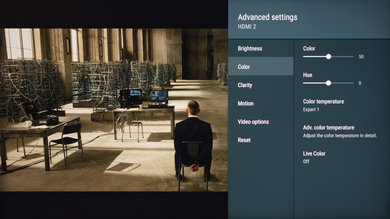- Table of Contents
- Top
- General Settings
- Miscellaneous settings
- White Balance
- Discussions
These are the settings we used to calibrate the 43" Sony XBR43X800E TV. We expect these to be valid for the 49" version (XBR49X800E) and the 55" version (XBR55X800E). They are good for any type of content, from watching movies and TV shows to gaming. For Gaming, some minor adjustments need to be done to have the best performance, and they are listed below.
Before we start, it is important to know that on Sony TVs each input has it own independent picture setting. This means that settings changed while on HDMI 1 won't be applied to HDMI 2. It is important to change the settings to your liking for each input, as changes in one input won't affect the rest. OTA channels, Apps (Netflix, YouTube, etc.), USB files (videos or picture) and video inputs and so on won't share settings.
General Settings
The first thing we did was to set the 'Light sensor' to 'Off" since we did not want the luminance of the TV to change depending on the ambient light level. We also set to 'Off' the 'Auto picture mode' since we did not want the TV to change picture mode depending on what type of content we played. For movies and TV content, we selected the 'Custom' 'Picture Mode' as it is the picture mode that brought us the closest to our calibration goal. Note that we always aim to display any content closest to what the creator intended and this means displaying the content without any added image processing.
In the 'Brightness' tab, we set the 'Brightness' to the minimum to reach a luminosity level closest to our calibration target of 100 cd/m² in our totally dark room. This should be adjusted to match your room lighting, and it won't affect the picture quality. We left the 'Contrast' to 90, the 'Gamma' to 0 and the 'Black level to 50, their default values. 'Adv. contrast enhancer' was left turned off, since we don't want to add any image processing to the original content
In the 'Color' tab, we left at the default value of 50 for 'Color' and 0 for 'Hue'. We selected 'Expert 1' for the 'Color temperature' as this is the closest to the warm temperature of 6500K we are aiming to achieve during calibration. If you find the color temperature to be too warm (reddish or yellowish) you can set it to a colder temperature. 'Live Color' was also left turned off, once again because we do not want to add extra image processing.
In the 'Clarity' tab, we left 'Sharpness' to 50 its default value (at 50, there is no added sharpness). 'Reality Creation' was also left turned off. It could be turned on if you are watching some older content with a lower resolution like DVDs or low-quality streaming content since it can help to improve the quality of the image. You can adjust with the 'Resolution' slider depending on how much effect you want to be added. The 'Mastered in 4K' option is a feature that will optimize the upscaling of 1080p Blu-rays movies that are listed as being 'Mastered in 4K'. It will not be possible to apply this setting if you are not watching a movie through other means than via a Blu-ray player, so in our case, we did not use this feature. 'Random noise reduction', 'Digital noise reduction' were all left turned off, but those could be useful to ameliorate the quality of older and low-resolution content.
In the 'Motion' tab, 'Motionflow' and 'Cinemotion' were left turned off for calibration, but if you like the motion interpolation (also named the soap opera effect), simply adjust the 'Motionflow' setting to 'Custom' and increase the 'Smoothness' slider. For a stronger SOP, set the smoothness slider at a higher value (you can read more on the motion interpolation feature here). The 'Clearness' slider controls the image flicker control of the TV. To know more about this feature you can click here. If you are watching a 24p movie via a 60p/60i source, you can set the 'CineMotion' to 'Auto" to help remove judder, but unfortunately, some minor judder does remain. You can read more on our judder test here.
HDR Settings
When HDR content is detected the TV will switch automatically to the good settings, but if you want to be sure you can verify that the 'Brightness' is set to maximum. In the 'Video options', also verify that 'HDR mode', 'HDMI video range' and 'Color space' are set to 'Auto' and it should change automatically to match the type of content you are watching, in this case, HDR content.
SDR and HDR Gaming
For playing games via a video game console or PC (in SDR or HDR) simply choose the 'Game' 'Picture mode', and you can keep the general settings previously mentioned. Note that some options may not be available in game mode since most of the image processing is turned off while in game mode.
Miscellaneous settings
If you want to connect via HDMI, a device that needs to use the full HDMI bandwidth, you'll need to set the 'HDMI signal format' to 'Enhanced format' via the 'External inputs' setting page. Note that on the X800E, only HDMI port 2 and 3 can transmit the full HDMI bandwidth.
White Balance Settings
The following are the results of the white balance and colorspace calibration on our unit. They are provided for reference, and should not be copied as the calibration values vary per individual unit even for the same model and same size as the TV we reviewed due to manufacturing tolerances. If you want to try them you will need to enter all values shown, as all of them are active at the same time. If you end up with worse picture quality, simply reset them to the default values.






























































